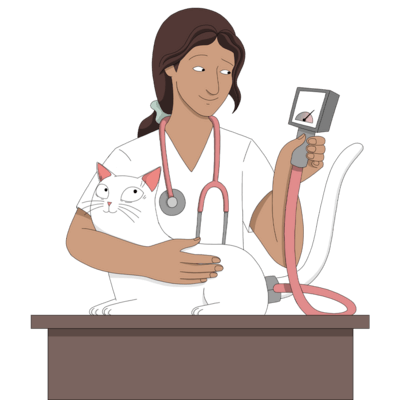
Measuring blood pressure in cats
What is blood pressure?
Blood circulates around the body within blood vessels, under pressure, caused by the contractions of the heart. Blood pressure refers to the amount of pressure within these blood vessels. If blood was not under pressure (from the heart beating), it could not be pumped and flow around the body. Blood pressure is therefore affected by the heart contractions (beats), and also by the size of the blood vessels and by the volume of the blood.
Blood pressure must be very carefully maintained within a narrow range by the body: if the pressure is too low (hypotension) then blood will not be able to reach vital organs in the body effectively, whereas if it is too high (hypertension) this can cause damage to vulnerable blood vessels and organs.
How do we measure blood pressure in cats?
When measuring blood pressure in cats, we usually measure what is called ‘systolic’ pressure – that is the pressure in the blood vessels when the heart contracts (beats) and the highest point of blood pressure in the vessels.
For accurate blood pressure measurements, cats must be as calm and relaxed as possible. Measuring blood pressure at home might be ideal, but is often difficult due to the skills and equipment needed. At a veterinary clinic, using a quiet room and allowing the cat time to relax helps minimise and stress. Using a synthetic facial pheromone (FELIWAY®) in the room and/or on the cat's bedding may also help to reduce stress.

Devices for blood pressure measurement
Various types of equipment can be used to measure blood pressure in cats, similar to the procedure in people. Usually, an inflatable cuff is placed around either a leg or the tail which is briefly inflated to stop the flow of blood through a vessel. A detector is used to monitor both the flow of blood and the pressure in the cuff - the pressure in the cuff is slowly released and the point at which blood flow first returns in the vessel is the systolic blood pressure. Measuring blood pressure is not painful or invasive, and most cats tolerate it extremely well. Usually, the cuff will be inflated a few times to get the cat used to the sensation and typically several consecutive blood pressure readings are taken.
How often should blood pressure be measured in cats?
Hypertension is most common in older cats; therefore, it is recommended that all cats over the age of 7 should have their blood pressure routinely checked – at first perhaps once a year, but increasing to twice a year in cats aged 11 and above (as the risk increases with age).
In addition, blood pressure should always be checked in any cat diagnosed with hyperthyroidism or chronic kidney disease (both common underlying causes of hypertension); and in cats with heart disease, sudden onset of blindness, or other ocular or neurological signs that might be caused by hypertension.
What is normal blood pressure in cats?
As in humans, 'normal' blood pressure is actually quite difficult to define as it may vary with many factors (age, breed and weight of the cat for example, individual variation, daily fluctuations, and the level of arousal of the cat). However, in general, systolic blood pressure measurements in healthy cats are typically around 120 - 130 mmHg, but can range from around 110 - 150mmHg and may sometimes be higher.
